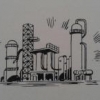Latest Downloads
-
 Water Bath Indirect Heaters
Water Bath Indirect HeatersArt Montemayor - Oct 12 2018 02:35 PM
-
 Petroleum: A Primer for Kansas
Petroleum: A Primer for KansasArt Montemayor - Oct 12 2018 02:27 PM
-
 Spray Tower for Flue Gas Scrubbing Design
Spray Tower for Flue Gas Scrubbing Designankur2061 - May 02 2018 02:31 PM
-
 Selection of Vertical Tanks
Selection of Vertical Tanksankur2061 - Apr 19 2018 07:42 AM
-
 Pressure Drop Calculator for Strainers 1
Pressure Drop Calculator for Strainers 1ankur2061 - Mar 24 2017 02:04 PM
-
 Horizontal Pig Trap System Design Guidelines
Horizontal Pig Trap System Design Guidelinesankur2061 - Jan 14 2017 02:54 PM
-
 Performance Prediction of 3-Stage Propane Refrigeration System
Performance Prediction of 3-Stage Propane Refrigeration Systemankur2061 - Aug 08 2016 02:43 PM
-
 Centrifugal Pump Troubleshooting Checklist
Centrifugal Pump Troubleshooting Checklistankur2061 - Dec 17 2015 08:18 AM
-
 Compressor Troubleshooting Checklist
Compressor Troubleshooting Checklistankur2061 - Sep 08 2015 11:43 AM
-
 Amine Sweetening Unit Preliminary Design
Amine Sweetening Unit Preliminary Designankur2061 - May 19 2015 09:35 AM
Popular Store Titles
 Tank Jacket Calculator
Tank Jacket Calculator
 Specification Sheet Collection
Specification Sheet Collection
 PIPESIZE
PIPESIZE
 Relief Valve Sizing
Relief Valve Sizing
 Rupture Disc Sizing
Rupture Disc Sizing
Chemical and Process Engineering Resources
Submitted Chris Haslego, Nov 21 2011 11:21 AM | Last updated Nov 21 2011 01:29 PM
| Category: | Plant Basics |
| Question: | Where can I find some details about applying and maintaining insulation on LPG (liquefied petroleum gas) lines (cold application)? |
| Keywords: | lpg,liquefied,petroleum,gas,insulation,condensation,problems |
| Answer: | BACKGROUNDLately, after operating our gas based LPG unit for more than 10 years, I am noticing a lot of 'on-the-surface' water condensation on some lines and vessels without any major changes in process or atmospheric conditions. We use glasswool and expanded foams with Al-cladding for insulation. ANSWERFirst and foremost: insulation in this type of application is the toughest to deal with and is directly subject to the technique, scrutiny and craftsmanship used in specifying, applying, inspecting and maintaining it. The aluminum or metal cladding jacket used is of minor insulation importance other than mechanical protection. The real important issue in this application is the VAPOR BARRIER employed in the installation. The ability to effectively seal the insulation substance from infiltration by atmospheric moisture determines the success or failure of the application. I have used FoamGlas, styrofoam, Polyurethane foam, and glasswool and can state from field experience in this type of process that any of the above will last efficiently as long as the respective vapor barrier is effectively keeping out the destructive effects of atmospheric moisture condensing and subsequently solidifying at the interphase of the cold vessel wall and the insulation. Once this occurs, the effectiveness of the insulation is neutralized and diminished from a practical point of view. All you have left as insulation is the insulating effect of the water ice formed and the insulation has to be removed due to saturation and water logging. The manual labor involved can be so expensive that normally the insulation's salvage is not justified.That is why, although more expensive, FoamGlas is more desirable over a long term. This insulation has impermeable glass cells that are not penetrated by moisture. However, any unsealed seams between the blocks of FoamGlas are subject to infiltration by the atmospheric moisture. So, you again have a problem that is directly attributable to lack of good craftmanship. The selection of an experienced, responsible and serious contractor is of primary importance in these engineered installations. Do not be misled into selecting a contractor based on price alone.Your gas plant seem to be a candidate for a complete re-insulation job. You should already have an engineering specification that clearly and accurately details out the insulation specifications for the contractor to follow and for you to inspect, check and approve in the field. All bidders should follow the same specifications. I have participated in the preparation of some of these type of specification packages and I can attest to the fact that they can get very technical, detailed and voluminous. You have a serious job on your hands because from what you describe, you are approaching a situation where the incremental loss of insulation effect and mechanical disintegration will force you to have to re-insulate the plant. When properly done, cold insulation has lasted me for 12 to 15 years with watchful and detailed maintenance of the vapor barrier. If your location is a humid one, your maintenance is more important. However, even plants in desert or arid areas are subject to vapor barrier maintenance.From your description, I believe you're facing a complete re-insulation job. For easier future maintenance, use a zoning method to allow for future patching without having moisture infiltrate all of your insulation. |
Forum Quick Links
Tech Q & A Category List
-
 Bulk Solids
Bulk Solids
-
 ChE Outside the Plant
ChE Outside the Plant
-
 Chemical Process Business
Chemical Process Business
-
 Chemistry Basics
Chemistry Basics
-
 Corrosion
Corrosion
-
 Equipment Design
Equipment Design
-
 Experimentation and Testing
Experimentation and Testing
-
 Fluid Dynamics
Fluid Dynamics
-
 Heat Transfer Technology
Heat Transfer Technology
-
 Industrial Utilities
Industrial Utilities
-
 Mass Transfer
Mass Transfer
-
 Physical Property Information
Physical Property Information
-
 Plant Basics
Plant Basics
-
 Plant Economics
Plant Economics
-
 Preparing to Become an Engineer
Preparing to Become an Engineer
-
 Process Control
Process Control
-
 Reactions and Processes
Reactions and Processes
-
 Refining
Refining
-
 Safety
Safety
-
 Separation Technology
Separation Technology
-
 The Environment
The Environment
-
 Thermodynamics
Thermodynamics

 FB
FB



0 Comments